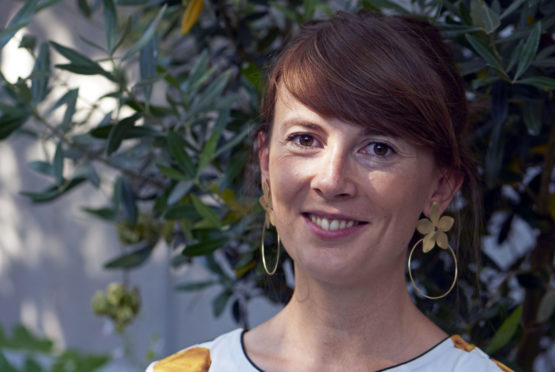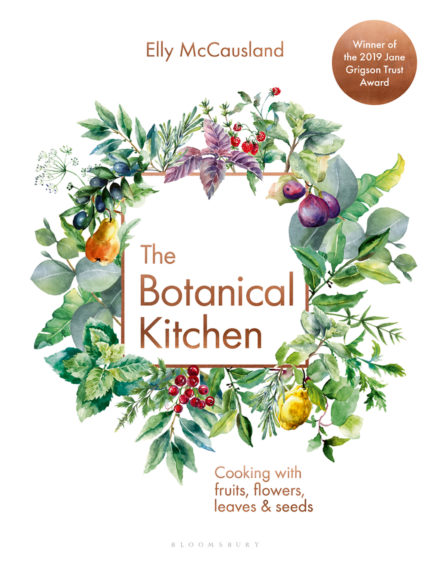
Many of us probably eat “botanical” ingredients all the time – in curries, stir-fries and takeouts from our local Thai – but how much attention do we pay to them?
We’re talking flowers, seeds, leaves and fruit – and food writer Elly McCausland is on a mission to bring these small underrated ingredients to the forefront and celebrate the big role they can play.
“They aren’t always centre-stage but they’re the backbone of the dish and provide really important flavour accents – we don’t always give these ingredients as much attention as they deserve,” she says.
“A lot of the time, we think about the protein first, or the carbohydrate, and then we build a dish from there, whereas I’m thinking, ‘OK, I have a pear, what can I do with that?’ Or a pineapple.”
Her first cookbook, The Botanical Kitchen, is packed with recipes celebrating fruits (such as orchard fruit or berries), leaves (banana leaves, kaffir lime leaves and herbs), flowers (lavender, saffron and elderflower) and seeds (cardamom or poppy).
And it’s all about letting these little powerhouses shine by doing as little as possible to them: “A lot of the recipes are quite natural and simple.”
But some might feel alien to many home cooks. After all, how often do you cook with flowers?
“When I was describing the book to someone and said there was a chapter on flowers, they looked at me like I was a bit mad,” McCausland admits. “I discovered lamb goes really well with lavender – just enough to get a slightly resinous, grassy taste. It really brings out the natural herbiness of the meat. Ditto with chicken and rose!”
But she knows these ingredients can seem daunting. “My advice would be to use sparingly. They are quite powerful, like rose and lavender, you don’t want to end up with a dish tasting like soap.
“But the other thing I’d say is to be open-minded. We tend to associate floral flavours with sweets – Turkish delight, sugared violets – but a little bit of floral can have a wonderful effect on savoury food.”

Think lavender, lemon and goats cheese focaccia, or chamomile rice with teriyaki pork and picked apple salad.
Are people she cooks for surprised by her (sometimes) unusual flavour combinations?
“Yes, I think so. I hope pleasantly surprised! One of the recipes, blue cheese risotto with caramelised balsamic pears… pears with risotto sounds strange and I’ve had some sceptical reactions, but people end up loving it. It’s the same with duck and lychee or anything with tea in it.”
British but based in Oslo for her other job as a university lecturer, McCausland has taken a lot of inspiration from her travels around the world. There’s North African and Middle Eastern notes in her cauliflower, date and preserved lemon dumplings with pomegranate and tahini dipping sauce, and Japanese influence in her soba noddles with crab, pomelo, yuzu and avocado.
“There are cuisines that are a lot more complex than ours in their use of botanicals. Thai, Indian and South-east Asian food – if you think of the number of botanicals that go into a simple soup, or for a Thai curry paste, you’re looking at probably 15 different ingredients, most of which are botanicals – galangal, lemongrass, vine leaves…
“The way they layer flavours, that’s something we’re working on in our cooking in Europe but it’s something certain countries have been doing for thousands of years.”
Something else that fascinates her is the history of these ingredients: “Knowing more about the story behind the recipe can make you want to make it and enjoy it more. A lot of these ingredients we use without thinking – especially common ones like bananas or apples.”
In the book, she talks about the disappearance of British and local apple varieties and the history the UK has with saffron. “A tiny part of me hopes I can get people to try to take food for granted a bit less and enjoy local produce.”
It seems to be a culture she’s picked up on in Scandinavia (she lived in Denmark before Norway). “One of the things I really admire, particularly in Sweden and Denmark, is people love food but they have a good sense of balance, a bit like the French. You notice that no one seems unhealthy. Everyone is fit and active. And they know when food is a treat to save for a special occasion.”
She says there’s also less of a diet culture. “When they have cake, they have a little bit and that’s enough. It’s a really healthy attitude. It’s somehow ingrained into the culture to enjoy good food, but not too much and not too little.
“I think we could actually learn a lot from that.”
Baked Brie
Baked Brie – gooey and straight from the oven – is the perfect crowd-pleaser if you have guests round. This version by Elly McCausland pimps the classic with tangy blackcurrants, buttery pecans and fragrant herbs.
“I like to serve it with Scandinavian-style rye crackers but a good, crusty baguette is also excellent for transporting cheese to mouth,” she says. “I highly recommend blackcurrant vinegar (I get it from demijohn.co.uk), but you could replace it with the more common raspberry vinegar, or a syrupy balsamic.”
Serves: 4-5
You’ll need
- 45g pecan nuts
- 250g wedge of Brie
- 70g fresh or frozen blackcurrants
- 2 tsp thyme leaves or finely chopped rosemary needles
- 3 tsp blackcurrant vinegar or balsamic vinegar
- 3–4 tsp runny honey
Method
- Pre-heat the oven to 190C/170C fan/gas mark 5.
- Put the pecans in a small oven dish and place in the oven for eight minutes, until toasted. Remove (leave the oven on), set aside to cool, then roughly chop.
- Take a small baking dish, the right size to fit the piece of Brie snugly. Slice the Brie horizontally in half (so you have two flat triangles). Put one half in the dish, cut side up. Take half the toasted pecans and press them gently into the cheese. Do the same with the blackcurrants (some will fall off the sides into the dish – that’s fine, but try to get as many as possible on the cheese). Sprinkle over half the thyme or rosemary, then drizzle over half the vinegar and half the honey.
- Put the other piece of Brie on top, rind side upwards (so you have essentially sandwiched the cheese back together as the wedge it was). Press the remaining pecans and blackcurrants onto the top of the cheese (again, some will fall off). Drizzle over the remaining vinegar and honey and sprinkle with the remaining thyme or rosemary.
- Bake for 10–15 minutes, or until the cheese has melted and spread out a little in the dish. Remove from the oven, leave for five minutes, then dive in with crackers.
The Botanical Kitchen by Elly McCausland, photography by Polly Webster, is published by Bloomsbury Absolute, priced £26. Available now

Enjoy the convenience of having The Sunday Post delivered as a digital ePaper straight to your smartphone, tablet or computer.
Subscribe for only £5.49 a month and enjoy all the benefits of the printed paper as a digital replica.
Subscribe